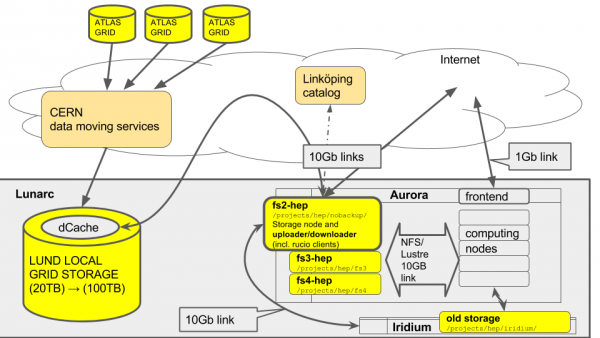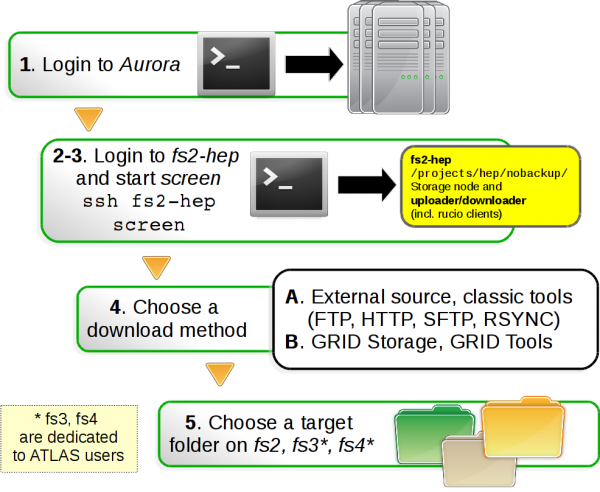User Tools
Sidebar
Table of Contents
Moving data to and from the cluster
Please read the section Storage before reading this section.
When moving data to the shared folders, please follow these common sense rules:
- Create folders for everything you want to share.
- If the data has been produced by you, is nice to create a folder with your username and place everything in it.
- If the data belongs to some specific experiment, dataset or the like, create a folder name that is consistent with that and that is easy for everybody to understand what that is about.
- Don't overdo. Only copy data you/your colleagues need. This is a shared facility.
- Don't remove other user's files unless you advice them and they're ok with it. This is a shared facility.
- Don't expect contents of any
scratchfolder to be always there. At the moment, however, there is no deletion policy for that.
Moving small files for users of Mathematical Physics and all Lunarc users
Small files, whose size are below 10GB, can be moved using aurora's frontend.
Users of Mathematical Physics, as well as any other Lunarc user, can use their favorite tool to download and upload either from your own workstation or laptop to the Aurora front-end or the Aurora computing nodes. You can read about some of those tools on the Move data to and from the Iridium Cluster pages.
For example, from your laptop:
sftp myfile aurora.lunarc.lu.se:/projects/hep/fs2/shared/np/myfolder/myfile
Moving big data for users of Nuclear, Theoretical and Particle Physics
For big files (hundreds of gigabytes up) you should use fs2-hep as described below. Aurora is not a storage facility, therefore is not meant to be accessed by external sources to do data movement. If you move big data via the Aurora frontend it is extremely slow and will slow down your colleagues work. Also, Aurora frontend managers might interrupt your transfers if they see it is taking too much time.
If handling big data, I strongly recommend to run an ssh/ftp server on your own laptop or workstation, or ask the sysadmin for a convenient form of online storage that can be accessed from Aurora as described below.
fs2-hep has a direct very fast 10GB connection to the internet for downloads and uploads.
Users of Particle and Theoretical Physics might need to download huge amount of data and therefore it was our goal to offload the Lunarc internal network and the usage of computing nodes as mere downloader nodes.
![]() NOTE
NOTE![]() incoming connections from the internet to fs2-hep are rejected. This node can download FROM and upload TO the internet but cannot be accessed directly as a server to retrieve or upload data from OUTSIDE Lunarc. In other words, it is not possible to directly connect TO
incoming connections from the internet to fs2-hep are rejected. This node can download FROM and upload TO the internet but cannot be accessed directly as a server to retrieve or upload data from OUTSIDE Lunarc. In other words, it is not possible to directly connect TO fs2-hep from the internet via sftp/ssh/rsync.
An overview of the upload/download components are shown in the slide below:
 source: https://docs.google.com/presentation/d/1agBLlMrMe3Pu1RGou5ut5LE0dgzeXFGztKu4Gjn_QBE/edit?usp=sharing
source: https://docs.google.com/presentation/d/1agBLlMrMe3Pu1RGou5ut5LE0dgzeXFGztKu4Gjn_QBE/edit?usp=sharing
Using the downloader node
- Login to aurora.lunarc.lu.se
- Login to
fs2-hep:ssh fs2-hep - Start
screen:screen - Choose one of the upload/download methods below.
- The download destination MUST be one of the
/projects/hep/folders or your home folder. All other folders are not writeable by your user. Everything in/tmpwill be deleted regularly.
A. Uploading/Downloading data to/from an external source from Aurora
- Use your favourite download software. Some suggestions are available at Moving data to and from Iridium. If the tool is not available please ask Florido to install it on
fs2-hep. - Use your home folder or one of the
/projects/hepfolders as a destination folder. Any other path is not writable by your user. The/tmpfolder will be deleted regularly so you should not use that./projects/hep/fs2is accessible by everyone, while/projects/hep/fs3and/projects/hep/fs4is dedicated storage for the ATLAS project.
B. Downloading/Uploading data to/from the GRID from Aurora
For resources that can be stored on the GRID, you should definitely stage them on the Lund GRID storage instead, a few ways described at the link below, so that you can access them from all over the world in the fastest way possible.
Please read the dedicated page Moving data between GRID and Aurora


